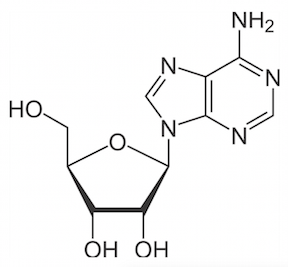This fundamental building block of life will stop your heart – just long enough to be useful
Major indications
In the ED, adenosine is used to terminate supraventricular tachycardias (SVTs). It is also used by cardiologists for pharmacologic stress testing. Paroxysmal SVT has a prevalence of around 2.25 per 1000 [1].
How it works
Adenosine is one of components of RNA, but given intravenously, it works to terminate SVTs by binding to the AV node’s A1 receptors. This inhibits adenylyl cyclase, ultimately increasing potassium efflux from the cell, causing hyperpolarization, and thereby “blocking” the AV node. This prevents atrial impulses from reaching the ventricles through the AV node, and also blocks re-entrant tachycardias that rely on conduction through the AV node.
Recently in the news
A recent retrospective study of the use of adenosine for termination of SVT in children found that adenosine was effective in 75% of cases, and that, in the majority of cases (70%), multiple doses were required [2]. In an unrelated development, a recent clinical trial suggested topical adenosine improved hair growth in alopecia, compared to minoxidil [3].
Notable History
The first report of adenosine used for SVT was published in 1976. At that time, adenosine was used in the form of ATP (Adenosine triphosphate) [4]. In the following decades, adenosine largely replaced verapamil as the first-line agent for SVT [5].
Adverse Events
The time from administration to effect is about 10-40 seconds. Expected side effects include a transient bradycardia or heart block during which time the patient may have a sense of anxiety or chest pain. Patients should be warned of this prior to administration. Other side effects include hypotension and in rare cases, prolonged heart block or dysrhythmias. However, the short half-life of adenosine (less than 10 seconds) means the side effects are typically brief and self-limiting.
Cautions
Adenosine is class C in pregnancy, but is the recommended first-line medication for termination of SVTs in pregnant patients when vagal maneuvers fail. If adenosine is ineffective, then propranolol or metoprolol can be used. Verapamil is less favorable as it can cause more maternal hypotension and potential decreased perfusion to the placenta and fetus. In unstable pregnant patients, cardioversion is still the recommended treatment [1]. Adenosine is considered safe in breast-feeding women [6].
Dose adjustments
Typical doses for terminating SVT are 6mg rapid IV push and flush in a proximal, large bore IV. If this is ineffective, then two subsequent doses of 12mg can be attempted. In children under 50kg, the dose is 0.05-0.1mg/kg. This dose can be increased by 0.05-0.1mg/kg and attempted twice more, with a maximum dose of 0.3mg/kg or 12mg. There are no dosing adjustments needed for patients with renal or liver disease. Caffeine and other methylxanthines, such as theophylline, have adenosine receptor blocking activity as a result of their purine structure, so higher doses may be required in patients who are on theophylline or who have had caffeine in the preceding four hours [7,8] (Caffeine’s effectiveness as a stimulant is largely accomplished through blocking adenosine’s inhibitory effects on the CNS).
If you are administering adenosine through a central line, then lower doses should be used (starting at 3mg) [9] to avoid side effects, such as prolonged bradycardia or heart block.
Special considerations
Adenosine is not typically effective for the termination of atrial flutter. When given to patients with flutter, the adenosine may ‘uncover’ the underlying flutter waves and help clarify the diagnosis if it was initially thought to be an SVT. In cases of rapid, regular, wide-complex tachycardia, it can be difficult to differentiate between SVT with aberrant conduction and ventricular tachycardia (VT). However, in the vast majority of cases, the patient should be presumed to have VT and treated as such.
Cost
Approximately $40 per 6mg dose in the United States.
REFERENCES
1. Blomstrom-Lundqvist C, Scheinman MM, Aliot EM, et al. ACC/AHA/ESC guidelines for the management of patients with supraventricular arrhythmias — executive summary— a report of the American College of Cardiology/American Heart Association Task Force on Practice Guidelines and the European Society of Cardiology Committee for Practice Guidelines (writing committee to develop guidelines for the management of patients with supraventricular arrhythmias) developed in collaboration with NASPE-heart rhythm society. J Am Coll Cardiol. 2003;42(8):1493-1531.
2. Diaz-Parra S, Sanchez-Yanez P, Zabala-Arguelles I, et al. Use of adenosine in the treatment of supraventricular tachycardia in a pediatric emergency department. Pediatr Emerg Care. 2014;30(6):388-393.
3. Faghihi G, et al. Comparison of the efficacy of topical minoxidil 5% and adenosine 0.75% solutions on male androgenetic alopecia and measuring patient satisfaction rate. Acta Dermatovenerol Croat. 2013;21(3):155-9.
4. Musto B, Greco R, Marsico F. Treatment of supraventricular tachycardia with ATP in adults and children. Boll Soc Ital Cardiol. 1976;21(1):45-53.
5. Belhassen B, Pelleg A. Acute management of paroxysmal supraventricular tachycardia: Verapamil, adenosine triphosphate or adenosine? Am J Cardiol. 1984;54(1):225-227.
6. Hale TW. Medications and mothers’ milk: A manual of lactational pharmacology. 12th ed. Amarillo, TX: Hale Publishing L.P.; 2012:1331.
7. Cabalag MS, Taylor DM, Knott JC, Buntine P, Smit D, Meyer A. Recent caffeine ingestion reduces adenosine efficacy in the treatment of paroxysmal supraventricular tachycardia. Acad Emerg Med. 2010;17(1):44-49.
8. Hayes B. Is the 6-12-12 adenosine approach always correct? Academic Life in Emergency Medicine Web site. http://www.aliem.com/is-the-6-12-12-adenosine-approach-always-correct/. Published 12/6/2012. Updated 2012. Accessed 11/25/2014.
9. McIntosh-Yellin NL, Drew BJ, Scheinman MM. Safety and efficacy of central intravenous bolus administration of adenosine for termination of supraventricular tachycardia. J Am Coll Cardiol. 1993;22(3):741-745.



